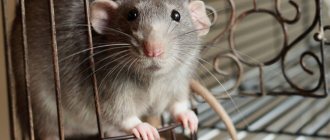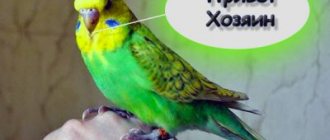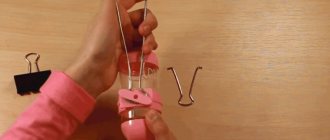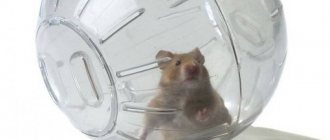In the wild, the hamster leads an organized life and can not only dig holes, but also sort grain by type in its pantries. At home, the rodent quickly gets used to the cage; it can run up stairs, spin a wheel and build a nest. All of these signs indicate that hamsters are trainable.
Let's find out how to help your pet quickly master simple and complex tricks.
How to train a hamster
Before starting classes, you should soberly assess your teaching abilities. Pets will perceive screaming and raising their voices as aggression and will lose interest in tricks, which for them are an ordinary game, but not a vital activity.
Don't expect too much from hamsters; they won't fetch objects on command (like dogs) or give up their paws. But it is quite possible to teach them to recognize their own nickname, identify their owner among other household members and climb into his palm. All this does not indicate the stupidity of rodents, it’s just that the capabilities of their intelligence have certain limits.
A few rules will help you get an idea of how to establish contact with the animal and train a hamster:
- Pets under 3 months of age are most receptive to learning. You can start classes 2 weeks after the birth of the rodent. It doesn’t matter what breed the pet is – Syrian, Djungarian and other hamsters are trained. But animals older than 3 months have already developed a behavioral model, so they are much more difficult to train.
- It is best to train and teach your pet tricks in the evenings, since this is the most active time of day for a hamster. He has already had a snack, slept and is ready to explore the surrounding space. You should not involve a lethargic, sleepy or aggressive rodent in the process.
- It is important to pay attention to the cleanliness of your hands and clothes. Animals have a rather acute sense of smell; the hamster can easily distinguish all kinds of aromas: food, perfumes, cleaning products, etc. An unfamiliar smell is a distraction that can both frighten a hamster and knock it out of a complacent mood.
- The best time for training is a short period of time after feeding, so that the pet is slightly hungry. Otherwise, it will not be possible to awaken interest in the trainer’s main tool (treats).
The key to successful hamster training is trust. When an animal is scared, it is impossible to teach it anything. First you need to tame the rodent so that it is not afraid of its owner, does not try to run away, hide or bite.
Affection, care, the pleasant smell of favorite treats from the hands of the owner, a quiet calm voice - this is where taming begins, and only then the pet will willingly run “into the arms” and allow itself to be trained.
Place something tasty on your palm and next to it. Allow the hamster to independently approach the owner's hand, eat next to it, and try to steal the treat from the palm. After this, having already become brave, he will climb into his hand. This is how trust develops between the animal and the owner.
Advanced maneuvers
Pirate and parrot
A parrot can be cheeky and fluffy, and not just feathered! To perform this trick, you will need long sleeves (they make it easier for the rodent to climb) and a treat.
The trick is performed in five steps:
- The hamster sits on your palm.
- To prevent the climb from being too steep, you need to bend your arm at the elbow and move it slightly to the side.
- Holding a treat in your other hand, you need to slowly lure the rodent onto your shoulder..
- Place food on your shoulder and let your hamster eat the treat.
- Repeat until the skill is established.
Weight lifting
To create an atmosphere of a healthy lifestyle and sports, you can make a barbell from edible items: carrots, apples, zucchini, cucumbers, etc. A block is made from solid oblong objects, and “pancakes” are made from round objects for a barbell. Such decorations look funny and will please your pet.
Jumping through a hoop
This great trick will tell you how to train a dwarf hamster. This breed of small rodents is distinguished by its jumping ability. To effectively use species characteristics, you can teach these nimble animals an interesting trick.
A small hoop, at least 5 cm in diameter, is used as equipment . A treat is placed in front of the hoop, and the hoop itself is raised to a height of 1 cm from the surface.
If you raise the hoop too high, the animal will run under it.
Barrier!
A simple structure of two disposable cups and toothpicks is constructed in front of the hamster. A piece of fruit is placed behind the barrier and the phrase “Barrier!” is said. In trying to get a treat, the animal will have to overcome an obstacle. After consolidating the skill, the animal will begin to jump over the barrier itself after a command.
Do hamsters bathe in water?
Simple tricks
Training a hamster begins with the simplest tricks, and moves on to more complex exercises if all participants in the process remain interested in the exercises.
Nickname knowledge
This useful skill must be mastered even if there is no interest in further training. If your pet suddenly gets lost in the house, the ability to respond to its own name will help it find its way to its cage. In the future, it will be much easier to teach the hamster commands if he responds to his name.
During the first few days, the nickname is repeated as often as possible: during feeding and communication with the animal, so that it remembers the sounds. As soon as the pet begins to respond, you can begin training to teach the hamster different tricks.
Important! You should choose a nickname according to the principle: sonorous and simple. A word that is too long will not work. You should also avoid hissing and dull sounds. Great options: Jim, Bob, Mike, Nyusha, Kai and others.
Run
To teach your hamster commands such as "run" and "run", you need to wait until he is hungry. A well-fed rodent will not want to run. You need to take a treat in your hand and bring it to your pet’s nose. Then move your hand along the desired trajectory of movement, while you need to say the command “run” or “run”.
After 1-2 laps, the hamster is given a treat. If you regularly repeat this exercise, you can ensure that the hamster learns to run several circles in response to a voice command.
Rack
The owner can quickly teach the hamster to stand on its hind legs, because animals are naturally able to do this at will.
The training should be as follows: the hand with the treat is raised above the rodent’s head so that it feels the tempting smell. As soon as he stands on his hind legs, repeat the command “Stop!” After several regular sessions, the hamster will remember this trick, especially if he receives his favorite treat and affection for his success.
Basic rules for training a hamster
Physical condition of the animal
You should not start training if your pet has health problems that cause him discomfort. Also, do not disturb the rodent during estrus, mating, or pregnancy. During such periods, hamsters will not be able to exercise to their full potential, and any training will end in failure.
Times of Day
The most suitable time for training is evening. Closer to night, hamsters are at the peak of their activity; they are more resistant to perceiving new information and working through exercises. As soon as your pet gets out of its house after a nap, you can safely start working with it.
Satiety
Train your pet on a moderately full stomach; when hungry, the pet will be distracted by extraneous odors, and the training will fail. Your hands should also be clean and free of food odor.
Confidence
Before a long training process, you need to build a trusting relationship with the rodent, you need to educate it and accustom it to your presence. A strong bond can be established through hand feeding. This way the pet will understand who its owner is and will get used to your smell.
Age
Training a hamster should begin at the right age - from 2 weeks from birth to 2.5 months of conscious life. This period is the most optimal period for training a hamster; at this time, he best perceives information and shows curiosity about the outside world.
IMPORTANT: If you start training too late, the exercises will not bear significant fruit, since the pet will not want to change its usual lazy lifestyle.
Hamster training - more complex commands
After the rodent remembers simple commands, you can continue training and teach the hamster more complex tricks. This is a task that will require quite a lot of time and effort on the part of the animal owner.
Coup
A simple command performed by a fluffy hamster looks funny, which is why many owners try to train their pets. If you put a small piece of apple on the animal's back, it will have to tip over to get to the treat. In this case, you must repeat the command: “Coup!”
Bounce
You can make your pet jump with the help of his favorite treat above his head. During the lesson you need to repeat the word “Jump!”
Ugh
For each completed command, you need to pet the pet and give it a treat, and in case of an incorrect movement or an intention to chew something forbidden, you should give the command with your voice: “Ugh!” A trained hamster will quickly remember a new word, which will simplify training in the future.
Running in a circle and standing
Some breeders claim that their hamsters obey commands such as “Sit!” or “Eat!” However, this is rather the exception than the rule. This is too difficult for most rodents. Two simpler commands, running in a circle and “Stop!” will tell you how to train a Djungarian and Syrian hamster.
To learn to run in a circle, it is best to use the following method:
- Keep his favorite treat close to the animal's nose, and then gradually begin to move it.
- The rodent will begin to move after the treat and as a result will move in a circle.
Just don’t tire him out; two or three laps is enough for the first time.
The “Stop!” command is taught in a similar way, but in this case the food must be placed on the pet’s head. Before you start training, make sure your hamster is hungry, otherwise he will not reach for food.
What tricks can your pet still learn?
Place the hamster in your palm and use a treat to guide him along your arm to your shoulder. When the rodent completes the task, give it food. Next time, he will run on his own initiative to receive a reward.
To practice the “Draw!” command, you need to take something tasty in your hand and slowly draw a simple figure (circle, square, hexagon) on a flat surface. At the same time they repeat: “Draw!” In the future, the hamster will run after the hand as soon as it hears a familiar word.
Important! You should not repeat their achievements after other breeders. It is quite possible that in the process of training your pet you will be able to invent a new trick.
Combining techniques
If you have a question about how to train a hamster to create an entire circus routine, then this chapter is for you. For this purpose, tricks are selected that do not tire the animal too much, so the performance lasts no longer than 7 minutes .
This combination of tricks can be used at a rodent show:
- The hamster climbs out of the cage using a ladder.
- Overcomes the barrier.
- Describes a couple of circles or several figures.
- Climbs onto the owner's shoulder.
After each trick, the hamster should be rewarded with a treat.
How to train a hamster to a wheel
It is believed that it is easy to accustom a hamster to a wheel. Indeed, for these animals such entertainment often becomes a favorite. But if the hamster does not run in the wheel, you need to find out the reason.
It may be that the animal is uncomfortable running, for example, when the wheel is mounted too high or is difficult to rotate. As soon as the owner removes the obstacle, the toy will be in demand again.
Those who plan to train their hamster will have to stock up on treats, patience and free time.
You should not force adult animals to perform complex tricks; most likely, the pet will not obey its owner. But training with a young hamster will certainly be successful, because training a furry glutton is truly interesting and fun!
Possible problems
Training a hamster is a rather delicate and unpredictable process, so owners of such a pet often face many problems when taming a rodent. There can be many reasons for this, but in most cases it is a consequence of the animal’s timid nature, but this is its natural behavioral reaction.
Bites
A bite is a natural reaction of any animal to danger: in this way it defends itself or tries to prevent possible harm to itself. However, dzhungarikas often bite only in exceptional cases.
There may be several reasons for this:
- strong or unfamiliar odors;
- pain caused by human touch;
- irritability;
- prolonged stress;
- an attempt to protect one's territory from unauthorized entry.
The first thing to do if you are bitten by a pet is to identify the cause and eliminate it.
Next, it is imperative to eradicate any attempts to harm a person. To do this you need:
- The first contacts with the pet should be carried out exclusively with protective gloves or while walking;
- pick up your pet only after feeding;
- avoid squeezing, damaging, or frightening the animal;
- gradually increase the duration of direct contacts from several minutes to several tens of minutes.
Learn how to make a labyrinth, aquarium, house, carrier, wheel, leash for a hamster.
Runs away
Like a bite, an attempt to hide is a genetically determined norm that helps the animal avoid the fate of being eaten by a predator.
Fear is often caused by:
- new living conditions;
- natural cowardice in the face of larger objects;
- unfamiliar sounds, smells and objects.
In order to win over your pet, you should:
- Place the cage in a quieter place, away from loud noises. At the same time, the hamster should not be restricted from the outside world - he must see and hear his owners every day;
- When in direct contact with an animal, thoroughly wash your hands to remove foreign odors. Strong aromas are one of the main causes of excessive stress for a timid animal;
- avoid raising your voice and making sudden movements when communicating with the dwarf;
- at each open contact, reinforce communication with a small piece of treat;
- get rid of the method of excessive pressure - the animal will show itself as soon as it gets used to the new conditions.
Find out what to do if your hamster is obese.
The Djungarian hamster is a fairly smart and quick-witted animal, which is why it can be easily not only tamed, but also successfully taught even complex commands. Today this is not only a whim of some owners, but also a necessary norm that helps turn a wild rodent into an affectionate and good-natured animal. However, in order to properly train a Djungarian, you will need not only perseverance and great desire, but also quite a long time and tolerance.
Errors
It is important to eliminate errors so that possible problems are avoided. If you get too carried away with upbringing, you can discourage the animal from wanting to learn and make contact. Training a hamster is possible only within the framework of mutual joyful communication, otherwise contact can be lost forever.
You shouldn't punish your hamster, it won't help. A long hunger strike, and even more so physical punishment, will scare away your pet.
Strangers, animals, and strong odors can frighten the hamster and distract him from his activities.
Raising your voice at an animal is unacceptable.
Feeding your hamster to capacity before training is a big mistake. The animal will become sleepy and lose incentive to work.
You should not demand a higher education diploma from your furry pet. If you use training elements for pleasant communication with the animal, listen to its mood and do not frighten it, the hamster will probably master several tricks. Trained pets bring a lot of positive emotions, so it's worth exploring the talents of your furry friend.
Peculiarities of raising different breeds
Dzungarian
Aggressive, biting rodent. The temper of the Djungarians can only be curbed at a young age. When purchasing, make sure that you are purchasing a young hamster, otherwise the training will not be successful. Before you treat your dwarf with your hands, wash them thoroughly and rub them with litter from the cage. A familiar smell will reduce aggression. This breed of rodent has poor eyesight. They use smell and touch to explore the world. The Dzhungarik may lightly claw its owner for informational purposes. Don't scold him for biting him like that.











